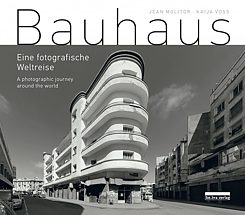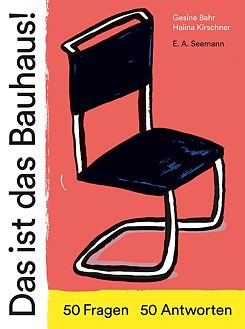100 years of Bauhaus
Bauhaus – still a good idea
100 years of Bauhaus – an excellent reason to celebrate! And a welcome occasion for publishers to present us with new books about the revolutionary arts school. Three titles approach the Bauhaus phenomenon in their own special ways.
By Marit Borcherding
In 1919, Walter Gropius founded the “Staatliches Bauhaus” in Weimar. A training facility that brought fine art and crafts together for the first time. The Bauhaus would prove to be the 20th century’s most influential educational institution in the fields of architecture, fine art and design.
BauhAus all Over THE WORLD
The coffee-table book Bauhaus – Eine fotografische Weltreise [Bauhaus – a photographic journey around the world] documents just how strongly modern architecture was inspired by the innovations of the Bauhaus, far beyond Germany’s borders. Travelling to numerous countries and continents, photographer Jean Molitor has captured this influence on camera. In an interview, Molitor explains that he likes to take his photographs at five in the morning: “It’s important to me to photograph these houses in a way that makes them appear timeless. Makes them come close to the architect’s idea.” Consequently, all of the photographs in this volume are in black and white and depict, for the most part, in almost understated aesthetics only the buildings themselves, no people, no cars, nothing that would detract from the buildings or obscure the viewer’s gaze.The text, by journalist and history of architecture lecturer Kaija Voss, describes both vividly and in-depth how Neues Bauen was reflected in Germany and throughout the world: in Chemnitz, Frankfurt am Main, Zwickau and Hamburg just as much as in Prague, Istanbul, Miami or Tel Aviv. In this volume, concise, staged photographs and equally concise texts offering an engaging overview complement each other perfectly – and, as an added bonus, they do so in both German and English.
A Competent NetwOrker
It is well known by now that while women certainly had a place at the progressive educational institution that was the Bauhaus, they did tend to be in areas that were considered feminine, such as weaving and textile art. Today, these women are gradually being brought out of obscurity and into the public eye. This is what Jana Revedin, a professor of architecture, aims for as well. Her book Jeder nennt mich hier Frau Bauhaus [Everyone here calls me Mrs Bauhaus] is dedicated to the work of Ise Frank. She was the second wife of Bauhaus founder Walter Gropius, but as this entertaining and informative book, described as a biographical novel, demonstrates, she was also so much more. Ise Frank, bookseller, literary critic and journalist, quit her job at a Munich bookshop and followed Walter Gropius to Weimar – not just for love but because the project itself excited her: “Here, one was allowed to try things out, revise, start anew, do better, revise again … Every project seemed to create its own dimension, arising from the exchange of opinions and experiences of the various disciplines … It was as if Ise wanted to find a metaphor for her own métier, like writing texts as a collective, with a dream team consisting of [Karl] Kraus, [Thomas] Mann, Huxley und Virginia Woolf ...”From then on, she was the one who took care of organisational matters in her stout and clear-sighted way, while her husband had rather less of a talent for everyday issues. She recruited patrons when bankruptcy loomed, she ran public relations with well-researched, specialised texts and press releases, and she was the first to advocate for the “home of the emancipated woman”, furnished with all the latest equipment. Above all, Ise Frank made sure that the Bauhaus ideas lived on even after the Nazis forced it to close and its members emigrated to other countries. The book, partly based on sources and partly fictional, not only closes a knowledge gap with regards to essential female Bauhaus protagonists but also tells the poignant story of female friendship between Ise Frank and the no less glamorous photographer Irene Hecht.
QUESTIONS – AnSwErS – QUESTIONS
Over the course of a hundred years of history, one or another of the Bauhaus principles may well have been forgotten. The anniversary thus provides a great occasion to collate and present all the ideas, visions and the ongoing impact of the Bauhaus in a compact manner. In their book Das ist das Bauhaus [This is the Bauhaus], writer Gesine Bahr and illustrator Halina Kuschner attempt exactly that. With a concept that makes sense: They approach the topic by asking questions – precisely 50, by the way – under the heading “What was the Bauhaus?”: from “Why is the Bauhaus called Bauhaus?” and “Why were steel and glass such popular materials?” all the way to “What was a Bauhaus party like?”The answers, clearly written yet by no means lacking in detail, usually consist of two or three pages each – an intelligent and entertaining read for Bauhaus novices of all ages as well as anyone looking for a quick and easy way to refresh their knowledge. Halina Kirschner’s illustrations are a huge bonus. In the Bauhaus colours of red, yellow and blue, they are much more than just decorative elements between the texts – they transport the ideas and the spirit of the arts school in a beautiful, striking manner.
Right at the beginning, the book claims: “The Bauhaus was many things – but not boring.” After reading all three books, a succinct answer suggests itself: Definitely!
Voss, Kaija & Molitor, Jean: Bauhaus. Eine fotografische Weltreise / A photographic journey around the world
Berlin: bebra Verlag, 2018. 240 S.
ISBN: 978-3-89809-152-7
Revedin, Jana: Jeder hier nennt mich Frau Bauhaus
Köln: DuMont, 2018. 304 S.
ISBN: 978-3-8321-8354-7
You can find this title in our eLibrary Onleihe
Bahr, Gesine: Das ist das Bauhaus! 50 Fragen - 50 Antworten (Illustriert von Halina Kirschner)
Leipzig: E.A. Seemann Henschel, 2019. 192 S.
ISBN: 978-3-86502-408-4



